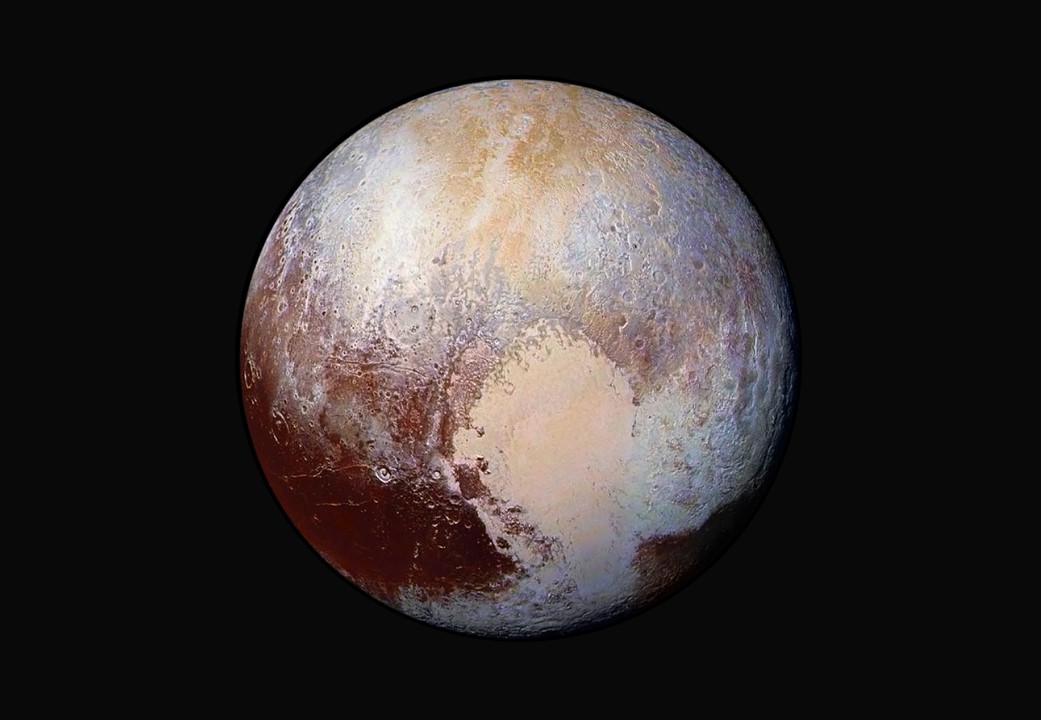The most recognizable feature on Pluto is its “heart,” a relatively bright valentine-shaped area known as Tombaugh Regio. How that heart got started is one of the dwarf planet’s deepest mysteries – but now researchers say they have come up with the most likely scenario, involving a primordial collision with a planetary body that was a little more than 400 miles wide.
Astronomers from the University of Bern in Switzerland and the University of Arizona looked for computer simulations that produced dynamical results like what’s seen in data from NASA’s New Horizons probe.
They found a set of simulations that made for a close match, but also ran counter to previous suggestions that Pluto harbors a deep subsurface ocean. They said their scenario does not depend on the existence of a deep ocean – which could lead scientists to rewrite the history of Pluto’s geological evolution.
University of Arizona astronomer Adeene Denton, one of the study’s co-authors, said the formation of the heart provides a critical window into the earliest periods of Pluto’s history, stating “By expanding our investigation to include more unusual formation scenarios, we’ve learned some totally new possibilities for Pluto’s evolution,” Similar scenarios could apply to other objects in the Kuiper Belt, the ring of icy worlds on the edge of our solar system.
The study focuses on the western half of the heart, a roughly 1,000-mile-wide, teardrop-shaped region called Sputnik Planitia. The region sits approximately 2.5 miles lower in elevation than the rest of Pluto and contains a larger variety of ice than the rest of the planet.
The vast majority of Pluto is composed of a layer of methane ice that has formed over the top of water-ice, making a methane-ice crust. However, within the Planitia, the ice is largely nitrogen-ice, which most likely accumulated after the impact due to the much lower altitude.
The eastern half of the heart is covered by a similar but much thinner layer of nitrogen ice. The origins of that part of Tombaugh Regio are still unclear, but it’s likely related to the processes that shaped Sputnik Planitia.
The researchers ran a wide assortment of computer simulations for the ancient impact. Those simulations reflected a range of sizes and compositions for the impacting body at different velocities and angles of approach. The best fit for Sputnik Planitia’s shape involved a 400-mile-wide object, composed of 15% rock, coming in at an angle of 30 degrees and hitting Pluto at a relatively low velocity.
Based on those parameters, the object would have plowed through Pluto’s surface with a splat. The resulting shape wouldn’t look like your typical impact crater. Instead, it would look like a bright, icy teardrop, with the rocky core of the impacting body ending up at the tail of the teardrop.
“Pluto’s core is so cold that the rocks remained very hard and did not melt despite the heat of the impact, and thanks to the angle of impact and the low velocity, the core of the impactor did not sink into Pluto’s core, but remained intact as a splat on it,” explained study lead author Harry Ballantyne, a research associate at the University of Bern.
Scientists were first able to view “Pluto’s heart” nine years ago, when the New Horizons Spacecraft did a fly-by of the planet. The spacecraft continues to fly through the Kuiper belt, an icy region containing Pluto and many more dwarf planets. Recently, scientists have detected higher than expected levels of interplanetary dust, suggesting more than originally thought is in the Kuiper belt. Scientists hope to find another icy world the spacecraft can closely observe by 2030.
How Pluto got its Heart
0




